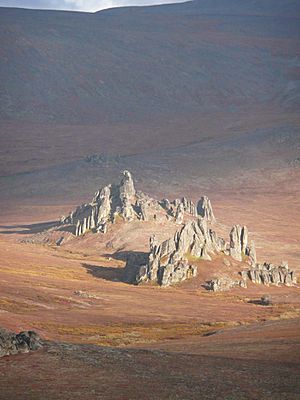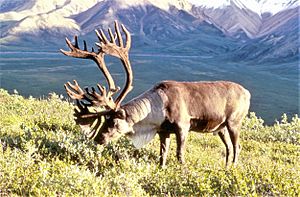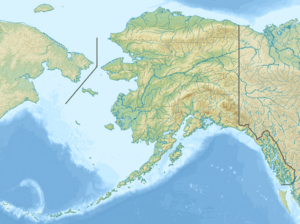Koyuk River facts for kids
Quick facts for kids Koyuk River |
|
|---|---|

Part of the Bering Land Bridge National Preserve, in the Koyuk River Valley
|
|
|
Location of the mouth of the Koyuk River in Alaska
|
|
| Native name | Kvyguk River |
| Country | United States |
| State | Alaska |
| District | Nome Census Area |
| Physical characteristics | |
| Main source | small lake 3 miles (4.8 km) north of Kuzitrin Lake Bering Land Bridge National Preserve, Seward Peninsula 1,526 ft (465 m) 65°25′44″N 163°13′00″W / 65.42889°N 163.21667°W |
| River mouth | Norton Bay Koyuk 0 ft (0 m) 64°55′45″N 161°08′03″W / 64.92917°N 161.13417°W |
| Length | 115 mi (185 km) |
The Koyuk River is a major river in western Alaska, United States. It flows across the Seward Peninsula. The river starts in the middle of the peninsula. It begins near the Lost Jim Lava Flow within the Bering Land Bridge National Preserve.
From its source, the Koyuk River flows southeast. It ends by joining Norton Bay, which is part of Norton Sound. The village of Koyuk is located right where the river meets the bay. The Peace River and Salmon River are its two biggest branches. Other smaller branches include Dime and Sweepstakes.
Contents
The Name of the Koyuk River
The Inuit people gave the river its first known name. They called it Kvyguk or Kvieguk. This name was reported by Captain Tebenkov in 1852.
Later, the Western Union Telegraph Expedition called it Koikpak. This means "big river." Over time, the name changed. It was spelled Koipak, Kayuk, and Kuyuk. The current spelling, Koyuk, was made official in 1900. This was done by the United States Geological Survey.
Where the Koyuk River Flows
The Koyuk River is one of the largest rivers on the Seward Peninsula. It starts from a lake that doesn't have a name. This lake is found in the Bering Land Bridge National Preserve. This area is in Northwest Alaska, near the Bendeleben Mountains.
The river is about 115-mile (185 km) long. It flows southeast for about 90 miles (140 km). Then it turns south for another 25 miles (40 km). The Koyuk River empties into Norton Bay. It enters the bay through a wide, watery area called an estuary. This estuary is near the village of Koyuk.
The last part of the river flows through a tundra wetland area. The land around the river forms a horseshoe shape. The hills in this area are between 2,000 to 3,000 feet (610 to 910 m) high. The two main mountains are the Bendeleben Mountains and the Domes of Granite Mountain.
River Features
At its beginning, the Koyuk River has steep slopes. It forms rapids in its highest parts. As the river flows downstream, it gets wider. More water comes from other streams that join it. The river can become as wide as 820 feet (250 m). In some slow-moving parts, the water can be 5-foot (1.5 m) deep.
Along both sides of the river, you can see exposed rocks. These rocks come from old lava flows. Pieces of these rocks have fallen into the riverbed, filling it with boulders. Scientists have studied the rocks in the valley. They found that these rocks are basalts from the Pleistocene Ice Age.
In 1973, the U.S. Bureau of Mines found some valuable minerals here. They reported finding Gold, platinum, and radioactive minerals. These were found along a 10-mile (16 km) wide stretch of the river.
The River Basin
Near its mouth, the Koyuk River becomes a wide estuary. This area is affected by the ocean's tides. It forms a flat basin filled with mud and sand. This basin covers about 2,000 square miles (5,200 km2). The Bering Land Bridge National Preserve is located in the highest part of this basin. The river's basin drains the southeastern part of the Seward Peninsula into Norton Bay.
History of the Koyuk River Area
People have lived near the Koyuk River for a very long time. Scientists found old remains at the Lyatayak site. This site is south of Koyuk. It shows that people lived there 6,000 to 8,000 years ago.
The first written history of Koyuk dates back to the 1840s. Lieutenant L.A. Zagoskin of the Imperial Russian Navy recorded it. In 1865, William Wennis reported that the village of Koyuk was empty. It was thought that a smallpox disease had wiped out the people. The village had been empty for 13 years.
Later, in the 1860s, Yupik-speaking people and Melemute Eskimos moved back to Koyuk. They came to herd caribou. In 1879, a trading post was set up at the river's mouth. It was run by the Alaska Commercial Company to trade furs.
During the gold rush, many people came to the area. However, not much gold was found in the Koyuk River valley. By 1900, the village went back to a simpler way of life. People depended on fishing, hunting caribou and moose, and gathering berries.
Wildlife and Nature

The Koyuk River is special. It is one of 25 rivers chosen as a National Wild and Scenic River. This means it is protected for its natural beauty and wildlife. The river and its surrounding land are full of amazing animals. There are five types of fish, 22 types of mammals, and 46 types of birds.
Plants and Habitats
The plants around the river change depending on the area. Close to the river, you'll find thick forests of needleleaf trees. There are also tall shrubs. Further away, you'll see open areas with low shrubs, willows, and grasses.
Wet, grassy areas are found between the river and higher ground. On the hills, you'll find tussock tundra. This is a type of grassland with bumpy clumps of grass. In the main valley, the plants are mostly tundras. But below Knowles Creek, you can find trees like willows, spruce, and birch.
Fish Species
The Koyuk River is famous for its fishing. Many different fish species live here:
- Chinook salmon (Oncorhynchus tshawytscha)
- Sockeye salmon (Oncorhynchus nerka)
- Coho salmon (Oncorhynchus kisutch)
- Steelhead/rainbow trout (Oncorhynchus mykiss)
- Dolly Varden trout (Salvelinus malma)
- Northern pike (Esox lucius)
- Grayling (Thymallus thymallus)
- Arctic char (Salvelinus alpinus)
Mammals and Birds
Many important mammals live in the river basin:
- Moose (Alces alces)
- Grizzly bear (Ursus arctos horribilis)
- Black bear (Ursus americanus)
- Caribou (Rangifer tarandus)
- Wolves (Canis lupus)
- Lynx
- Red fox
- Beaver
- Snowshoe hare (Lepus americanus)
Many bird species also live in the river area:
- Bald eagles
- Glaucous gulls
- Spruce grouse
- Northern flying squirrel
- Song birds
- Ravens
- Waterfowl (ducks, geese, etc.)
- Lesser golden-plover
- Whimbrel
- Lapland longspur
Fun Activities and Tourism
The Koyuk River basin has many trails for exploring. Two popular routes are the Koyuk River-Buckland route and the Koyuk-Kiwalik route. The river is also a great place for water sports. People enjoy kayaking and rafting here.


